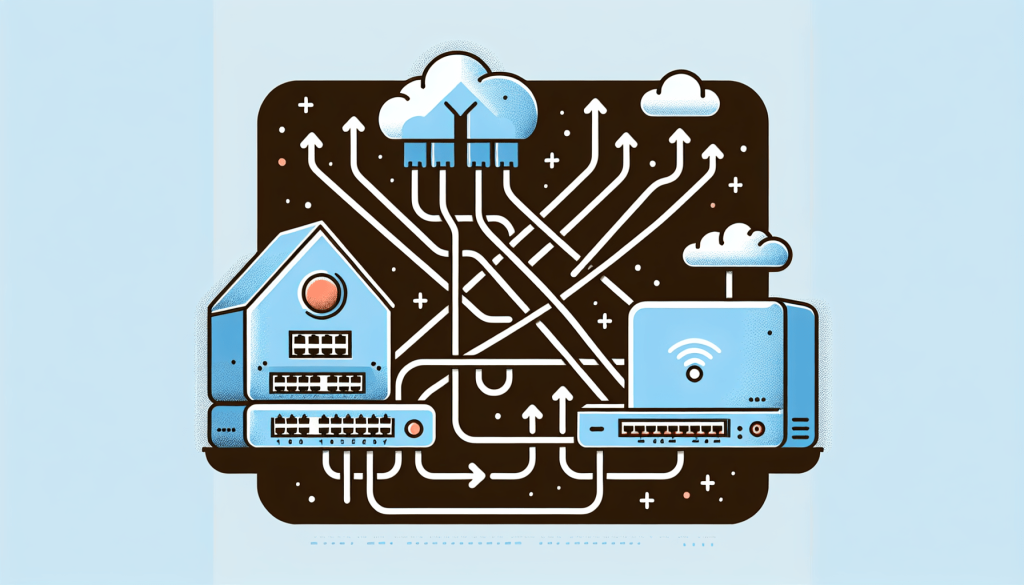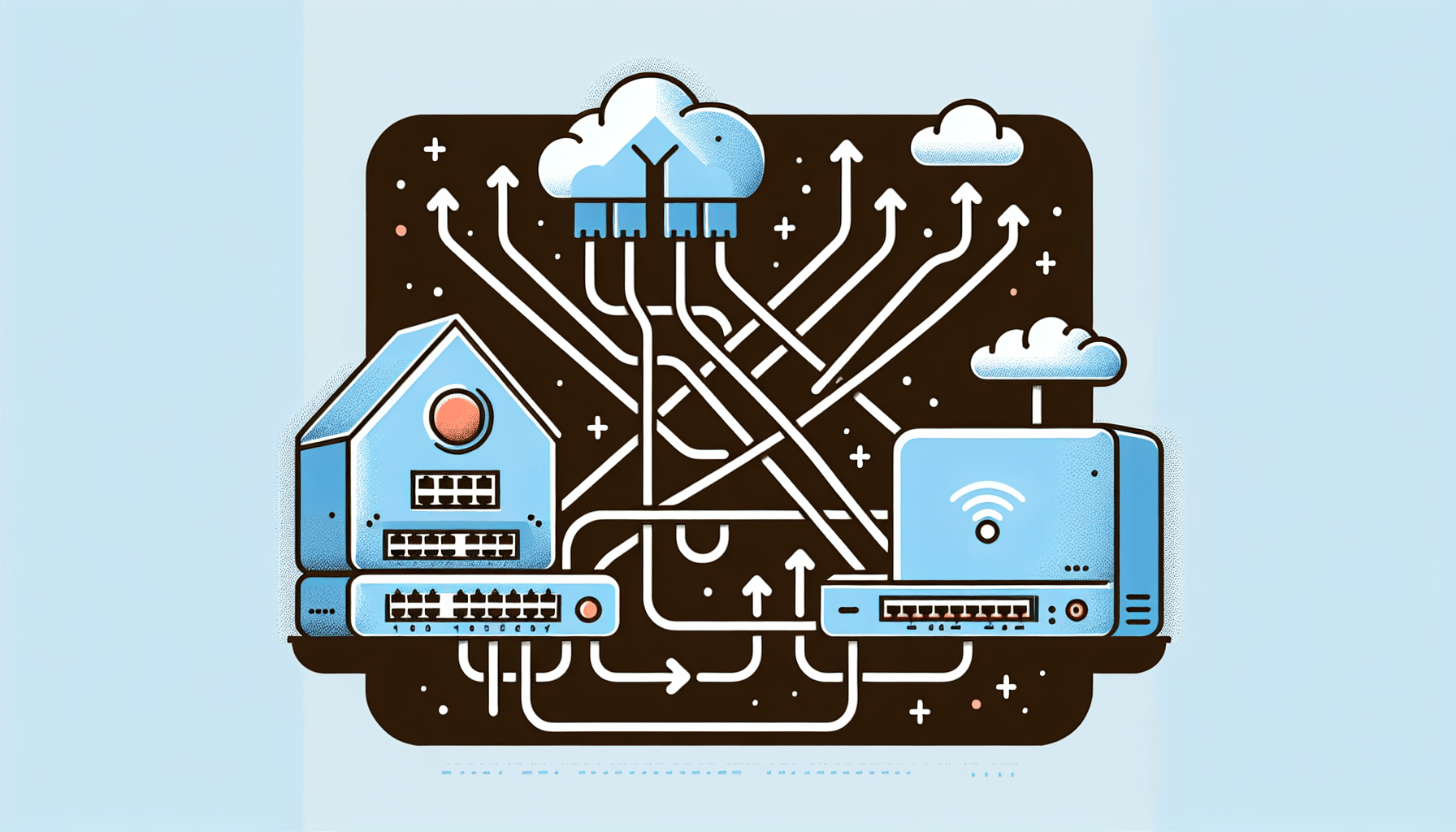In this article, you will gain a clear understanding of the distinction between network switches and routers. Have you ever wondered what sets these two networking devices apart? Well, worry no more! We will explore the key differences between network switches and routers, allowing you to confidently navigate the world of networking and make informed decisions when it comes to setting up your own network. So, let’s delve into the world of network switches and routers and discover the fascinating insights that await you!

What is a Network Switch?
Definition
A network switch is a piece of hardware that connects devices on a local area network (LAN). It acts as a central hub, allowing devices to communicate with each other by forwarding data packets between them.
Function
The main function of a network switch is to facilitate communication within a local network. It receives data packets from devices connected to it and forwards them to the intended recipient. This allows devices on the network to communicate efficiently and ensures that data is sent to the correct destination.
Types of Network Switches
There are different types of network switches available, each catering to specific needs. Some common types include:
-
Unmanaged Switches: These switches are plug-and-play devices that do not require any configuration. They are suitable for small networks or home use.
-
Managed Switches: Managed switches provide more control and scalability. They offer advanced features like VLAN (Virtual LAN) configuration, quality of service (QoS), and network monitoring.
-
PoE (Power over Ethernet) Switches: These switches combine networking capabilities with the ability to power devices over the Ethernet cable. They are commonly used in IP surveillance systems and VoIP phones.
What is a Router?
Definition
A router is a networking device that connects multiple networks together. It acts as an intermediary between devices on different networks, enabling communication between them by determining the best path for data to travel.
Function
The primary function of a router is to route data packets between networks. It examines the destination IP address of each packet and determines the most efficient route to deliver it. By doing so, routers ensure that data reaches its intended destination, even if the destination is on a different network.
Types of Routers
Routers come in various types, each designed for specific purposes. Some common types include:
-
Wired Routers: These routers connect networks using physical Ethernet cables. They are commonly used in home networks and small businesses.
-
Wireless Routers: Wireless routers are similar to wired routers, but they also provide wireless connectivity through Wi-Fi. They allow devices to connect to the network without the need for physical cables.
-
Core Routers: Core routers are high-performance routers used by internet service providers (ISPs) and large networks to handle large amounts of traffic. They are designed for speed and reliability.
Layered Functionality
Switches operate at Layer 2
Network switches operate at Layer 2 of the OSI (Open Systems Interconnection) model. Layer 2, also known as the Data Link layer, is responsible for the transfer of data frames between devices on the same network. Switches use MAC (Media Access Control) addresses to direct packets to the correct device.
Routers operate at Layer 3
Routers operate at Layer 3 of the OSI model, known as the Network layer. Layer 3 is responsible for logical addressing and routing packets between networks. Routers use IP (Internet Protocol) addresses to identify and deliver packets to their destinations.
Explanation of OSI Model
The OSI model is a conceptual framework that defines how different networking functions are implemented and interact with each other. It consists of seven layers, each with its specific role in the communication process. The layers are: Physical, Data Link, Network, Transport, Session, Presentation, and Application.
Packet Handling
Switches forward packets
When a switch receives a data packet, it reads the destination MAC address and checks its MAC address table to determine which port to forward the packet to. It then sends the packet only to the port where the destination device is connected. This process is known as forwarding.
Routers route packets
Routers, on the other hand, examine the destination IP address of a packet and determine the best path to deliver it. They maintain a routing table that contains information about known networks and their corresponding next hop. Routers compare the destination IP address with the entries in the routing table to determine the appropriate path for the packet. This process is known as routing.
Difference in packet handling
The key difference between switches and routers in terms of packet handling lies in the layer at which they operate. Switches focus on forwarding packets within a local network based on MAC addresses, while routers concentrate on routing packets between different networks based on IP addresses. This fundamental difference allows switches to provide faster and more efficient communication within a local network, while routers enable interconnectivity between different networks.

Network Size
Switches suitable for local networks
Network switches are typically used in local area networks (LANs) where the number of devices is relatively small. They are ideal for connecting computers, printers, and other devices within a home or office network. Switches allow devices to communicate with each other directly, making them suitable for networks with low latency requirements and high data transfer rates.
Routers essential for wide area networks
Routers are essential for wide area networks (WANs) that span larger geographical areas and connect multiple LANs. They enable communication between different networks by forwarding data packets across various network segments. Routers play a crucial role in directing traffic efficiently over long distances and ensuring that data reaches its intended destination, even across the internet.
Comparison of network sizes
In summary, switches are well-suited for local networks with a limited number of devices, offering fast communication within the network. Routers, on the other hand, are vital for wide area networks and interconnecting networks, providing the ability to route data between different networks and handle larger-scale communication.
Broadcasting
Switches broadcast data within the network
Switches allow devices within a network to communicate through broadcasting. When a device sends a broadcast message, such as a DHCP (Dynamic Host Configuration Protocol) request, the switch ensures that the message is delivered to all other devices connected to the network. This allows devices to discover each other and engage in network-wide communication.
Routers control and limit broadcasts
Routers, on the contrary, control and limit broadcasts within a network. They prevent broadcast messages from propagating beyond the local network, reducing unnecessary network traffic. Routers achieve this by segmenting networks into smaller subnets, creating boundaries that contain broadcast messages within a specific network segment.
Impact on network performance
The differences in broadcasting capabilities between switches and routers have implications for network performance. Switches, with their unrestricted broadcast capability, can lead to increased network traffic, potentially causing congestion and reducing overall performance. Routers, with their ability to control and limit broadcasts, help mitigate these issues, ensuring efficient and optimal network performance.
IP Addressing
Switches do not modify IP addresses
Network switches operate at Layer 2 and are not involved in modifying IP addresses. They rely on MAC addresses to direct packets within a local network. Switches learn the MAC addresses of connected devices through a process called MAC address learning, dynamically populating their MAC address tables as devices communicate.
Routers modify IP addresses
Routers, operating at Layer 3, are responsible for routing packets between networks. As part of the routing process, routers modify the source and destination IP addresses of packets, encapsulating them with new IP headers as they travel from one network to another. This IP address modification allows routers to determine the correct path for delivering packets to their destinations.
Importance of IP addressing
IP addressing is a critical aspect of network communication. It enables devices to be uniquely identified on a network, facilitating the routing of data packets to their intended recipients. Routers play a crucial role in managing IP addressing and ensuring seamless communication between networks, while switches focus on efficient local communication based on MAC addresses.
Security
Switches offer limited security features
Network switches generally provide limited security features compared to routers. While they can filter traffic based on MAC addresses, they lack advanced security capabilities such as firewalling or intrusion detection. Switches primarily focus on facilitating communication within a local network rather than implementing complex security measures.
Routers provide advanced security
Routers, on the other hand, offer more advanced security features. They can implement firewall rules to filter traffic based on various criteria, including source and destination IP addresses, ports, and protocols. Routers can also support virtual private networks (VPNs) to establish secure connections between networks, ensuring the confidentiality and integrity of transmitted data.
Comparison of security capabilities
When it comes to network security, routers offer more comprehensive and robust features compared to switches. Routers are often considered the gatekeepers between networks, providing protection against external threats and enabling secure communication across network boundaries.
Management and Configuration
Switches allow basic management
Network switches typically offer basic management capabilities. They allow administrators to configure settings such as VLANs, link aggregation, and port mirroring. Managed switches provide additional features like SNMP (Simple Network Management Protocol) for network monitoring and remote management options.
Routers offer extensive configuration options
Routers provide extensive configuration options to control network routing, security, and other aspects of network operation. Administrators can configure routing protocols, access control lists (ACLs), NAT (Network Address Translation), and other advanced features to govern network connectivity and behavior. Routers also offer remote management options for efficient administration of wide area networks.
Differences in management capabilities
The main difference in management capabilities between switches and routers lies in the levels of control and configuration they offer. Switches tend to provide more straightforward management options suitable for local network administration, while routers offer greater flexibility and control over network operations, making them ideal for managing complex network environments and wide area networks.
Conclusion
Summary of differences
In summary, network switches and routers serve different purposes and operate at different layers of the OSI model. Switches excel at facilitating communication within local networks, forwarding data packets based on MAC addresses. Routers, on the other hand, enable communication between different networks, routing packets based on IP addresses. They ensure efficient data transfer over larger distances and across various network segments.
Additionally, switches are primarily used in smaller network environments, providing fast and efficient local communication. Routers are essential for larger-scale networks, connecting multiple LANs and enabling communication over wide area networks. They offer advanced security features, manage IP addressing, and provide extensive configuration options.
Importance of understanding the distinction
Understanding the differences between network switches and routers is crucial for designing and maintaining effective network infrastructures. Being aware of their respective functions, capabilities, and roles helps network administrators make informed decisions when choosing the appropriate equipment for their specific networking needs. By leveraging the strengths of switches and routers effectively, organizations can build reliable and efficient networks that meet their communication requirements.
